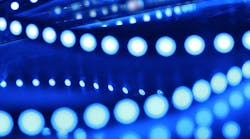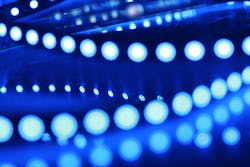When conducting an energy audit for a client, our firm is looking to reduce not only overall energy consumption, but energy spend. Thus, as one would expect, we are looking for as much low-hanging fruit as possible. In virtually all of the ASHRAE-compliant energy audits we undertake, we find the lowest-hanging fruit to be lighting—this in spite of the fact LED lighting is as commonplace today as incandescent bulbs were when I was a kid.
LEDs—and their associated control technologies—continue to improve, with lamp efficiencies getting higher and costs coming down. Additionally, some very unique LED-lighting products are starting to appear in the marketplace. One of the most intriguing is color tuning. It has been well-known for some time that warmer- (lower-) color-temperature lighting at lower intensity levels has a calming, restful effect on humans. (Think mood lighting on that special date!) With new color-tuning technologies, the color temperature—and intensity—of LED lighting can be varied according to task or environment.
Some of the most promising applications of color tuning are related not to vision, but to circadian and other neurological/endocrine responses in humans, especially among the elderly. Circadian rhythms are rhythms found in mammals (and certain other animals, plants, fungi, and microorganisms) that relate to the normal 24-hr cycle of light and dark attributed to the Earth’s rotation. In humans (and other mammals), the circadian timing system (CTS) is driven by an internal biological clock located in the hypothalamus of the brain. Although the CTS is endogenous, it is affected by external sources, including light—both wavelength and intensity.
As we age, the lenses of our eyes become thicker, which reduces the amount of light passing through to our retinas. Additionally, as we get older, the lenses of our eyes yellow. That acts to filter the long blue visible light that controls melatonin production in our bodies. This can result in insomnia and more serious symptoms, such as depression and circulatory problems. Individuals, particularly those who are ill, who do not receive exposure to blue light—either natural or artificial—can exhibit both physical and mental symptoms. Indeed, the correlation between lighting in health-care facilities and patient outcomes has been well-established.
Recently, I spent time with Rod Smith, chief technology officer for uSave LED and inventor of the WalaLight. Our firm is convinced use of this lighting technology in health-care and eldercare facilities could be beneficial to both the bottom line of the operation and the wellness of patients/residents. It could delay the transition from independent living to assisted living and from assisted living to memory care. And in VA hospitals, it could help physically and emotionally injured veterans get the rest they need and deserve.
Tunable LEDs also have a place in the outdoor environment. Coastal Florida is home to 90 percent of the loggerhead—the most common sea turtle found in Florida—nesting in the United States. As a beach resident in South Florida, where red/orange/amber turtle-friendly lighting is required from March through October, the idea of being able to design lighting that could be changed from turtle-friendly to bright, white pedestrian-safety lighting during winter—our “snowbird” season, when the local population is the largest—at the touch of a switch makes a lot of sense to me.
Lastly, although it’s not what comes to mind when we refer to tunable LEDs, my iPhone SE has a feature that automatically shifts the colors of my phone’s display to lower (warmer) color temperatures at night to help me get a better night’s sleep. Now, if Apple could only develop technology to get our dogs to sleep later in the morning …










